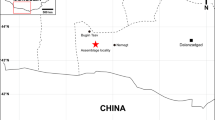Abstract
The anatomy of the saurischian dinosaurStaurikosaums pricei Colbert from the Santa Maria Formation (Middle or Upper Triassic) of Rio do Sul, Brazil is redescribed.Staurikosaurus has 9 (or possibly 10) short cervicals, 15 dorsals and 2 sacral vertebrae, a modified brachyiliac pelvic girdle and an elongate hindlimb with the tibia longer than the femur.
The new family Staurikosauridae is erected, the Herrerasauridae is redefined, and both families are considered to be Saurischia incertae sedis. The distal part of the “femur” ofPoposaurus gracilis Mehl (Upper Triassic, North America) is the ventral part of the pubes with a footed distal end but, because some members of the Poposauridae have an imperforate acetabulum, this family is transferred from the Saurischia (Theropoda, Carnosauria) to the Thecodontia (Pseudosuchia).
Zusammenfassung
Die Anatomie des SaurischiersStaurikosaurus pricei Colbert aus der mittel- oder obertriassischen Santa-Maria-Formation von Rio do Sul in Brasilien wird neu beschrieben: 9 oder 10 kurze Halswirbel, 15 Rücken- und zwei Sakralwirbel, modifiziertes Becken mit kurzem Ilium, lange Hinterextremitäten, Tibia länger als Femur. Begründung von Staurikosauridae nova fam., genauere Definition der Herrerasauridae. Beide Familien sind Saurisdiia incertae sedis. Der distale Teil des »Femurs« vonPoposaurus gracilis Mehl (Obere Trias, Nordamerika) ist der ventrale Teil des distalen Pubis-Endes. Wegen des imperforaten Acetabulums einiger Vertreter der Poposauridae wird diese Familie nicht mehr wie bisher den Saurisdiia (Theropoda, Carnosauria), sondern den Thecodontia (Pseudosuchia) zugerechnet.
Similar content being viewed by others
Literature
Barker, R. T. &Galton, P. M. (1974): Dinosaur monophyly and a new class of vertebrates. — Nature,248: 168–172; London.
Benedetto, J. L. (1973): Herrerasauridae, nueva familia de Saurisquios Triasicos. — Ameghiniana,10: 89–102; Buenos Aires.
Bonaparte, J. F. (1972): Annotated list of the South American Triassic tetrapods. — Proc. Sec. Gondwana Symp.: 665-682; Pretoria.
— (1975): The family Ornithosuchidae (Archosauria: Thecodontia). — Colloq. internat. CNRS.,218: 485–502; Paris.
Broom, R. (1911): On the dinosaurs of the Stormberg, South Africa. — Ann. S. Afr. Mus.,7: 291–308; Cape Town.
Case, E. C. (1922): New reptiles and stegocephalians from the Upper Triassic of Western Texas. — Pubis. Carnegie Inst.,321: 7–84; Washington.
— (1943): A new form of phytosaur pelvis. — Amer. J. Sci.,241: 201–203; New Haven.
Charig, A. J. (1967): Archosauria. — In: The fossil record [ed. Harland, B. et al.]: 708–718; London (Geological Society).
Charig, A. J.;Attridge J. &Crompton, A. W. (1965): On the origin of the sauropods and the classification of the Saurischia.— Proc. Linn. Soc. London,176: 197–221; London.
Colbert, E. H. (1961): The Triassic reptile,Poposaums. — Fieldiana Geol.,14: 59–78; Chicago.
--- (1964): Relationships of the saurischian dinosaurs. — Amer. Mus. Novitates, No.2181, 24p.; New York.
--- (1970): A saurischian dinosaur from the Triassic of Brazil. — Amer. Mus. Novitates, No. 2405, 39p.; New York.
Galton, P. M. (1971): The prosauropod dinosaurAmmosaurus, the crocodileProtosuchus, and their bearing on the age of the Navajo Sandstone of northeastern Arizona. — J. Paleont.,45: 781–295; Tulsa.
— (1973): On the anatomy and relationships ofEfraasia diagnostica (Huene) n. gen., a prosauropod dinosaur (Reptilia: Saurischia) from the Upper Triassic of Germany. — Paläont. Z.,47: 229–255; Stuttgart.
--- (1976): Prosauropod dinosaurs (Reptilia: Saurischia) of North America. — Postilla, No. 169, 98p.; New Haven.
Galton, P. M. &Cluver, M. (1976):Anchisaurus capensis (Broom) and a revision of the Anchisauridae (Reptilia, Saurischia). — Ann. S. Afr. Mus.,69: 121–159; Cape Town.
Huene, F. v. (1935–1942): Die fossilen Reptilien des Südamerikanischen Gondwanalandes. — Munich (C. H. Beck’sche Verlagsbuchhandlung).
Krebs, B. (1976): Pseudosuchia. — Handbuch der Palaeoherpetologie,13: 40–98; Stuttgart.
Marsh, O. C. (1885): Names of extinct reptiles. — Amer. J. Sci.,23 (3): 81–86; New Haven.
Mehl, M. G. (1915 a): The Phytosauria of the Trias. — J. Geol.,23: 129–165; Chicago.
— (1915 b):Poposaums gracilis, a new reptile from the Triassic of Wyoming. — J. Geol.,23: 516–522; Chicago.
Meyer, H. V. (1861): Reptilien aus dem Stubensandstein des oberen Keupers. — Palaeontographica,7: 253–346; Stuttgart.
Nopcsa, F. V. (1921): Zur systematischen Stellung vonPoposaurus (Mehl). — Zbl. Miner. Geol. Paläont.,1921: 348; Stuttgart.
— (1928): The genera of reptiles. — Palaeobiologica,1: 163–188; Stuttgart.
Owen, R. (1842): Description of parts of the skeleton and teeth of five species of the genusLabyrinthodon, etc. — Trans, geol. Soc. London,6 (2): 515–543; London.
Reig, O. A. (1963): La presencia de dinosaurios en los “Estratos de Ischigualasto” (Mesotriasico Superior) de las provincias de San Juan y la Rioja (Republic Argentina). — Ameghiniana,3: 1–20; Buenos Aires.
— (1970): The Proterosuchia and the early evolution of the archosaurs; an essay about the origin of a major taxon. — Bull. Mus. Comp. Zool. Harvard Univ.,139: 229–292; Cambridge.
Romer, A. S. (1956): Osteology of the reptiles. — Univ. Chicago Press, 772 p.; Chicago.
— (1966): Vertebrate Paleontology, Third ed. — Univ. Chicago Press, 468 p.; Chicago.
--- (1972): The Chanares (Argentina) Triassic reptile fauna. XVI. Thecodont classification.
--- Breviora,395: 24 p.; Cambridge.
Rozhdestvensky, A. K. (1966): Growth changes in Asian dinosaurs and some problems of their taxonomy. — Internat. Geol. Rev.,8: 782–793; Chicago.
Sill, W. D. (1974): The anatomy ofSaurosuchus galilei and the relationships of the rauisuchid thecodonts. — Bull. Mus. Comp. Zool. Harvard Univ.,146: 317–362; Cambridge.
Steel, R. (1970): Saurischia. — Handbuch der Palaeoherpetologie,13: 1–88; Stuttgart.
Walker, A. D. (1969): The reptile fauna of the “Lower Keuper” Sandstone. — Geol. Mag.,106: 470–476; Cambridge.
Welles, S. P. (1947): Vertebrates from the Upper Moenkopi Formation of Northern Arizona. — Bull. Dept. Geol. Sci. Univ. Calif.,27: 241–294; Berkeley.
Young, C. C. (1941a): A complete osteology ofLufengosaurus huenei Young (gen. et sp. nov.). — Palaeont. sin., C,7: 1–53; Peking.
— (1941b):Gyposaurus sinensis (sp. nov.), a new Prosauropoda from the Upper Triassic Beds at Lufeng, Yunnan. — Bull. geol. Soc. China,21: 205–253; Peking.
Author information
Authors and Affiliations
Rights and permissions
About this article
Cite this article
Galton, P.M. OnStaurikosaums pricei, an early saurischian dinosaur from the Triassic of Brazil, with notes on the Herrerasauridae and Poposauridae. Paläont. Z. 51, 234–245 (1977). https://doi.org/10.1007/BF02986571
Issue Date:
DOI: https://doi.org/10.1007/BF02986571




